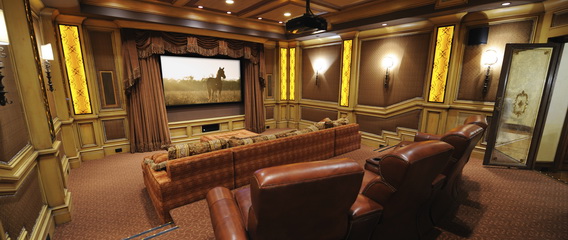After your James Bond marathon, do you feel fatigued? Have a crick in your neck? Feel like rubbing your eyes or have a headache? If you have any of these symptoms, you may be the victim of bad home theater Feng Shui! Don’t worry, with a few simple adjustments to your home theater you’ll be on the road to recovery, not to mention a more comfortable, inviting and enjoyable home entertainment experience.
Absolutely no wires
Most of us have fallen prey to perhaps the biggest media room no-no: exposed wiring, which is especially egregious with on-wall flat-panel displays. Wires should be hidden inside walls for the best results, which most likely means snaking wires from your TV/speakers to your components. Don’t worry, sprucing up your system is an easy fix and shouldn’t take an installer long or be hard on the pocketbook.
Best seats in the house
For a dedicated theater, you may want to install a few risers so that everyone in the theater has a proper view of the screen. If so, talk to your installer to make sure that the risers plus seating combine to give proper viewing clearance for the back rows. Also, make sure to plan for back-row risers to have adequate headroom. Too often home theater designers try to cram in as many seats as possible, making that back row a bit cramped and claustrophobic. Additionally, while sofas may offer a more casual aesthetic vibe, theater chairs are designed to ergonomically support your body for extended viewing.
Light appropriately
The right combination of lighting can really help to enhance your home theater experience. For example, think about installing aisle lighting so that people can get up during a film without having to turn on the lights or trip. We also recommend a soft light of some sort (such as fiber-optic star ceilings and LEDs) to minimize eyestrain from prolonged viewing in the dark.
In addition, your installer can program automated lighting scenes, like “Watch Movie” that will automatically tie into the film, gradually bringing lights down at the beginning and up at the end of the film. A good control system will allow you to do this and operate your system with ease.
Surface considerations
That shade of white really pops but did you know it can be detrimental to your onscreen image? Bright wall colors tend to reflect light back onto the screen, washing out the picture. Dark, neutral shades minimize light reflection and screen coloration. Also consider sound when selecting your surface materials. Hardwood floors or concrete will reflect sound, making the room sound like a basketball court. Temper them with plush sofas, pillows, drapes, or opt for carpet—all of which absorb sound.
Sound matters
Speaking of sound, ask your installer to soundproof your room so outside noise stays out, and you can crank the volume without worrying about waking up the neighbors. It’s also important to minimize ambient noise within the theater. For example, if your projector is noisy, consider putting it in another room behind optical glass, in a “hush box” or go with a quieter model. Also, think twice about putting noisy appliances, like a refrigerator or icemaker, in the back of the room.
Finally, make sure your installer does a thorough room acoustics calibration, because speakers react differently depending on room shape and size. Dialing them into your own space is a must for killer sound.
Picture perfect testing
This important step really hones your high-definition image to the very best it can be. Your installer can perform a series of tests to make sure your image is reference quality, allowing you the richest, sharpest and most beautiful image available from your display or projector. It’s worth the extra few steps!
These are just a few of our tips for making your home theater better. We hope you are inspired to make the most of your environment. Our installers and designers have years of experience creating the ideal movie haven or media space and are happy to answer any questions you have. If you’d like to learn more, give us a call or come in! We’re excited to share our passion with you.

